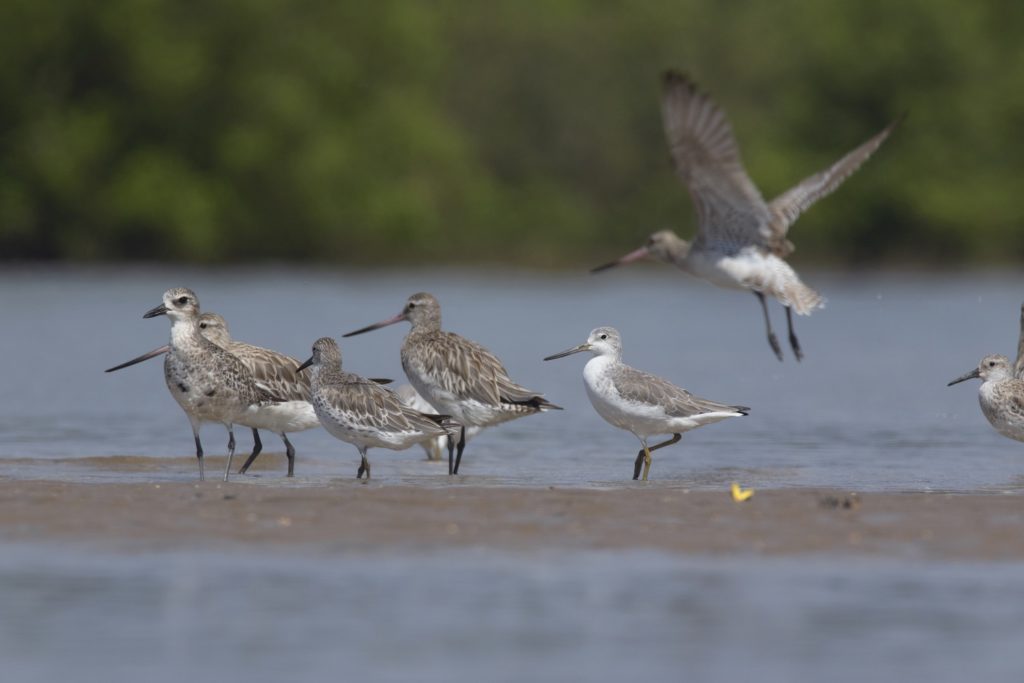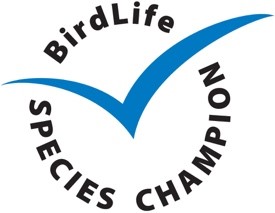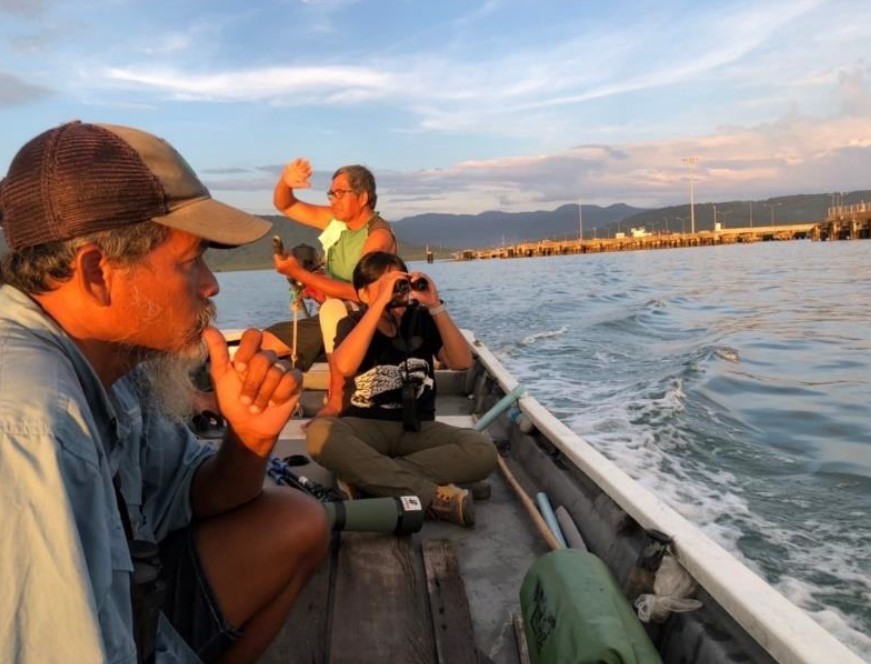The Spotted Greenshank, also called Nordmann’s Greenshank thanks to its Finnish discoverer, Alexander von Nordmann, is one of the most threatened shorebirds in East Asia. The species is so named thanks to the white spotting on its black top while the breeding period. The IUCN Red List considers the species as ‘critically endangered’. At the moment, scientists estimate a population of about 1,500 individuals. More positive surveys estimate a maximum of 1,500 to 2,000 sexually mature individuals, but with a declining trend.
Their habitats disappear
During the breeding period, the Spotted Greenshank prefers forested habitats with sparse larch trees and coastal meadows for their food search. Unusual among many shorebirds, the Spotted Greenshank builds their nests of twigs, mosses and lichens in larch trees two to four meters above the floor – most other shorebirds nests are on the ground. The female and the male Spotted Greenshank are both jointly involved in building the nest. Also, the roles of raising the chicks are shared by both parents.
A major threat for the Spotted Greenshank is that the species continue to be hunted in some breeding areas of Russia. In addition, its staging and wintering habitat has greatly declined thanks to expanding use of coastal areas in Asia for development, leading to widespread wetland loss. In China alone, 40 percent of the coastal wetlands which the species stage in has been lost since the 1990s. The species uses the East-Asian-Australian migration route, which is used by 60 different Eurasian wading bird species and which reaches until South-East-Asia, Australia and New Zealand.
As wintering habitats the Spotted Greenshank mainly uses low land sumps, but also wetland meadows, sand beaches and salt pans. The Spotted Greenshank bathes in streams of estuaries and might sleep for hours while standing and having the bleak under the wings. In its wintering fields they often form large flocks with other shorebird species. Its main wintering areas are in the coastline of Southeast Asia at from Bangladesh and the Gulf of Thailand, east to Vietnam. It has been also seen on its migration route through China, Hong Kong, Taiwan, North and South Korea, Myanmar, Cambodia and Vietnam.

The conservation work of BirdLife International and ZEISS
BirdLife International has spearheaded the Species Champions initiative for many years. Thanks to this initiative, BirdLife International and its Partners are able to organizes activities with the help of dedicated sponsors to protect globally threatened species by means of strengthening scientific knowledge, nature conservation measures, and advancing political and local engagement activities to secure the habitats of these target species. The success of this program is impressive: Since 2000, BirdLife International has worked to preserve the habitats of 25 species threatened with extinction. The quota of species threatened with extinction could be reduced by 40 per cent and between 21 to 32 species could have averted extinction.

Over the last several years, ZEISS had been “species champion” for the endangered Northern Bald Ibis. Now, ZEISS has since taken a role as “species champion” for the Spotted Greenshank. First, it is about the conservation of the wintering fields for the species. Working closely with BirdLife International, BirdLife’s Partner in Thailand, the Bird Conservation Society of Thailand has developed and organised a five year program for the conservation of coastal wintering sites on the Thai coastline with Zeiss’s support, including activities to monitor and manage a private nature reserve and adjacent areas of wetlands that provide wintering habitats for the Spotted Greenshank. There is also work to engage local stakeholders on the importance of the site. They include publicity and awareness activities that show the importance of the species and their habitats. Camps and photographic competitions are also being developed to strengthen public interest and there is work to develop salt-based products from salt harvested from salt pans, which benefit shorebird habitats whilst addressing the livelihoods of people.



This commitment towards the conservation of the Spotted Greenshank is an important priority for ZEISS. With the conservation of its wintering fields the chance to conservate this special and rare species is given. ZEISS has regarded it as a central duty to prevent species from extinction for many years and sponsors the work of BirdLife International in its activities regarding the “species champions” and the scientific as well as conservation work regarding the red list of endangered species.
Impressive successes by the local initiatives
Through the Species Champions initiative, ZEISS has supported the activities of local groups, strongly engaged to save the habitats of the Spotted Greenshank. Local groups, coordinated by the Bird Conservation Society of Thailand organize work to protect habitats, engage local people and mobilise resources towards the conservation of the species. The progress of their work is steady. In February 2022, more than 10 sites along the long coast of Thailand were surveyed by BCST’s field teams and more than 300 individuals were counted, or nearly a quarter of the known population. The local experts inform about the conservation of the Spotted Greenshank as well as the conservation of other shorebirds.
“ZEISS’s support has been critical in helping us to build the evidence base as to which are the most important wetland sites for the Spotted Greenshank in Thailand, which is the single most important country for wintering populations of this unique shorebird.”
Ding Li Yong, Asia Advocacy and Policy Manager, BirdLife International
The information happens for example in online seminars via social media channels with internationally well-known guest speakers from BirdLife International and the University of Florida with 200 online participants as well as personally close to the habitats. By this way, they engage volunteers to commit themselves in bird and nature conservation projects. In addition, the groups increase the awareness of landowners and the local governments for the relevance of the birds and their needs for conservation, they show risks and activate the responsible persons to meet those risks proactively.
East Asian-Australasian Flyway (EAAF)
There are a total of eight migratory bird flyways around the world. Among the largest flyways is the East Asian-Australasian flyway, which is used by more than 200 species of waterbirds, including shorebirds such as the Spotted Greenshank. Many shorebirds breed in north-east Asia (eastern Siberia, Mongolia and northern China), from the Taimyr Peninsula in the far north of Russia, east to Sakhalin Island, Kamchatka and Alaska. These birds migrate south across China, Japan and Korea towards Southeast Asia before the onset of winter, sometimes to as far as Australia and New Zealand, to spend months of the boreal winter there, and covering round-trip distances of up to 20,000 km each year. The epic journeys of Bar-tailed Godwits across the Pacific to the east coast of Australia and New Zealand from Alaska involves non-stop flights of up to 13,000 km is an excellent example. During their migration, these birds rely on productive resting places, many coastal wetlands, to gather enough energy for the next period of their journey. The Yellow Sea region surrounded by China and Korea forms the most important stopover sites for many of these migratory waterbirds in the EAAF.
About Post Author
Visits on this Page:3634